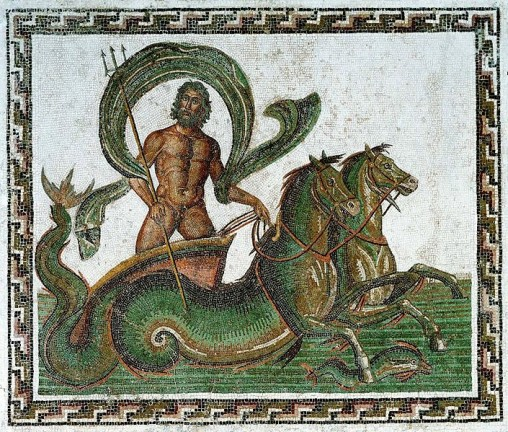A silver didrachm from Taranto in southern Italy minted during the period 355-340 BC. It features on obverse a male youth riding a dolphin.
Dolphins and a dolphin-rider feature so prominently on the coinage of Taranto. This is unsurprising, given the mythological aetiology of the city from the hero Taras, the son of Poseidon (Pausanias 10.10.8). who was shipwrecked and then rescued by a dolphin.
On this coin from Taranto minted during the period 355-340 BC, Taras is depicted holding his father's trident...
The dolphin-rider motif appears early on the coins of Taranto. For instance, a silver didrachm from Taranto minted during the period 510-450 BC
With a Reverse this time featuring a winged hippocamp symbol of Poseidon.
Poseidon was god of the sea, storms...and horses. This is reflected in his epithets: Nauklarios (Ναυκλάριος) "belonging to the ship-owners", Pelagikos (Πελάγίκος) "belonging to the sea"...and Hippeios (ἲππειος) "belonging to a horse"...
Sailors prayed to Poseidon for a calm seas and safe voyage, "sometimes drowning horses as a sacrifice"...
In Greek art, Poseidon rides a chariot that was pulled by a hippocampus or by horses that could ride on the sea...
Poseidon is apparently "...more often regarded as the tamer of horses, but in some myths he is their father, either by spilling his seed upon a rock or by mating with a creature who then gave birth to the first horse..."
In Arcadia, one of the most conservative parts of Ancient Greece, Poseidon was worshipped as a stallion...
Why? Why?
The natural breeding season of horses starts in Apr/May and ends in Sep/Oct and is marked by wild stallion fights for mares...
The horse fertility is governed by the sunlight and peaks on summer solstice. I heard summer solstice was a big thing for sun worshipers....
Hence solar horses all over Eurasia...
Articles about solar horse (equid):
Iran "Water carrier equid", "Dioscuri plate from Iran"
Mesopotamia "Shamash playing with the solar horse", "Sun god from Tell Brak"
India "Hayagriva"
China "Longma", "Three legged crow", "Mythical beast from Xian"
Levant "Alexamenos graffito", "Goddess on a horse", "Unicorn"
Europe "Archaic rider", "Beotian solar pyxis", "Pegasus and chimera", "King John", "The horseman"
Ok, but what does this have to do with Poseidon? Well, mating season of horses, overlaps with the sailing season in the Eastern Mediterranean. Both start in Apr/May and finish in Sep/Oct...
I talked about this in my post "Trojan horse", in which I asked a question: was Trojan horse "hypos" - a wooden horse left as tribute, or "hypos" - a wooden boat with a horse head used for transporting tributes...
The reason for this is that dolphin mating and calving season in Mediterranean spans period May-Oct.
It takes place in the shallows, and is therefore easily observable by people living and fishing along the coast...
So there is actually a symbolic link between the horses and dolphins. Their mating seasons overlap and they overlap with the sailing season in the Eastern Mediterranean...
I talked about dolphin as an animal calendar marker in many of my posts, like "Boat of Dyonisus", "Apollo and dolphins", "Horned animal attacked by a dolphin", "Minoan dolphin fresco", "Coin from Byzantion", "Eagle eating dolphin"
One other thing...A lot of the coins from Taranto depict a mounted warrior on the obverse. You can find them all here...
This one even depicts a mounted warrior and Nike, the goddess of victory...
Why?
Because Apr/May - Sep/Oct was not only the sailing season but also the war season...
Knowing this makes the original coin even cooler...I think...














No comments:
Post a Comment